Childhood Obesity: Causes, Consequences, and Prevention
VerifiedAdded on 2023/04/24
|11
|2593
|71
AI Summary
This document discusses the causes, consequences, and prevention of childhood obesity. It covers topics such as the background of childhood obesity, factors associated with the occurrence of this health condition, and recommendations for prevention. The target group for these health promotions activities would be school students aged 4-10.
Contribute Materials
Your contribution can guide someone’s learning journey. Share your
documents today.

Running Head: OBESITY
0
OBESITY
Student
[Pick the date]
0
OBESITY
Student
[Pick the date]
Secure Best Marks with AI Grader
Need help grading? Try our AI Grader for instant feedback on your assignments.
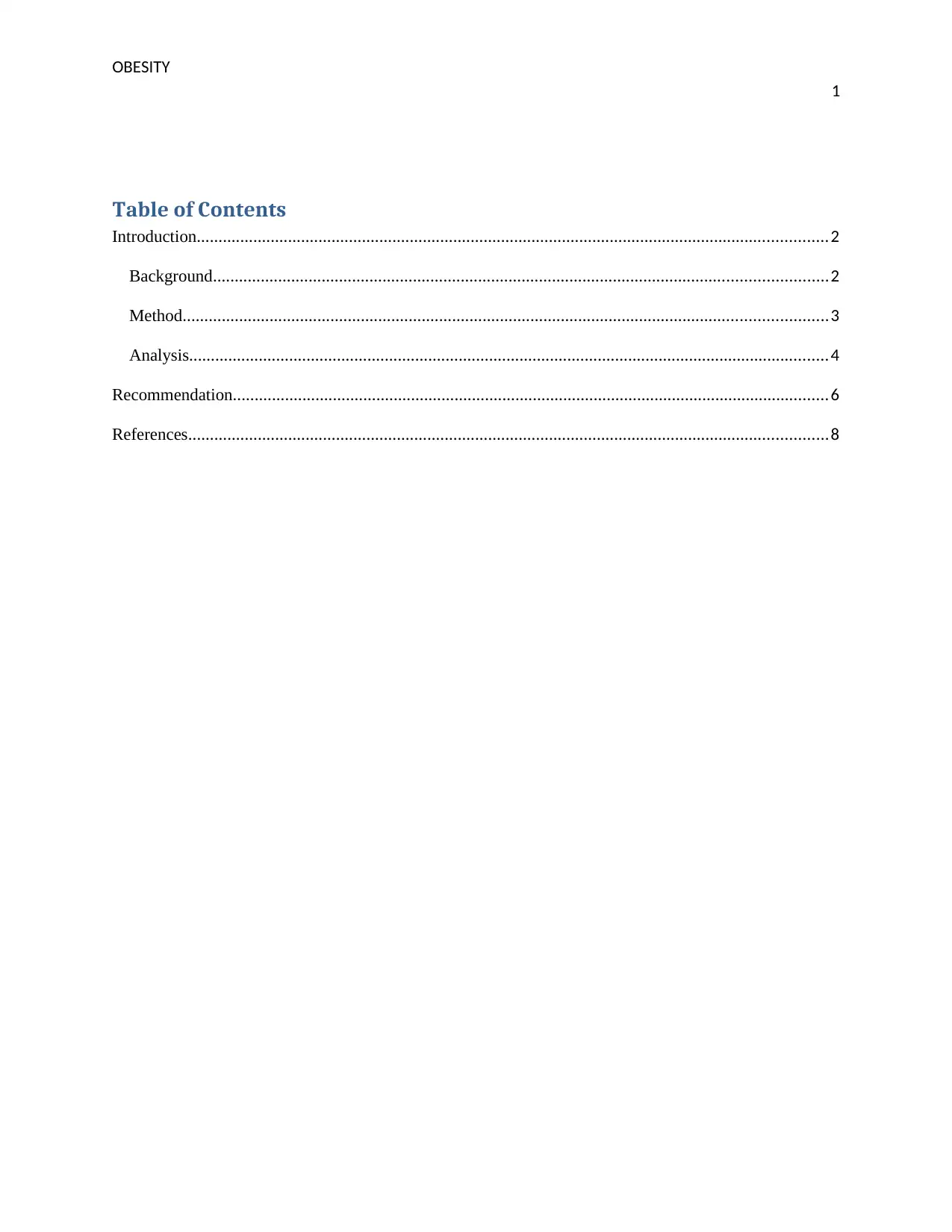
OBESITY
1
Table of Contents
Introduction.................................................................................................................................................2
Background.............................................................................................................................................2
Method....................................................................................................................................................3
Analysis...................................................................................................................................................4
Recommendation.........................................................................................................................................6
References...................................................................................................................................................8
1
Table of Contents
Introduction.................................................................................................................................................2
Background.............................................................................................................................................2
Method....................................................................................................................................................3
Analysis...................................................................................................................................................4
Recommendation.........................................................................................................................................6
References...................................................................................................................................................8
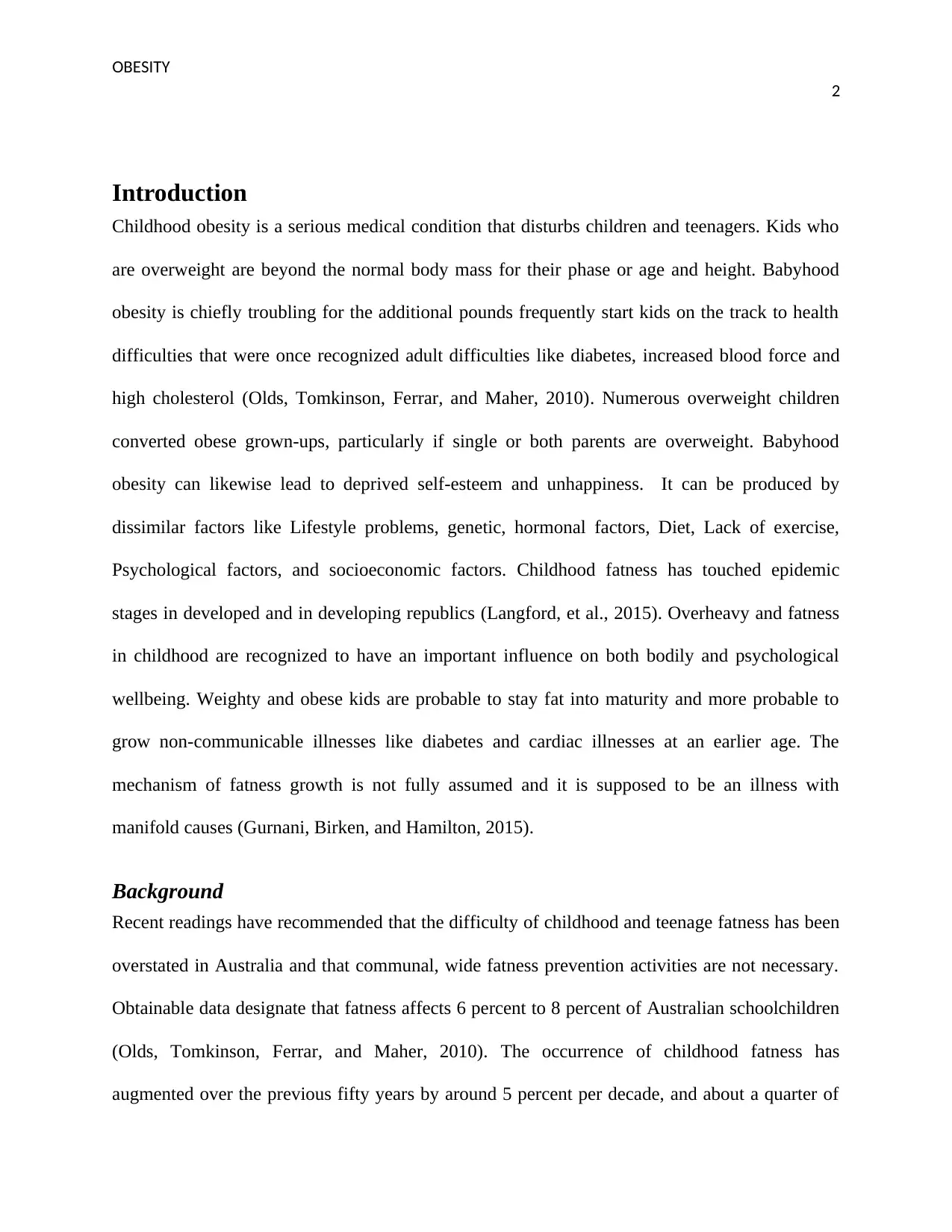
OBESITY
2
Introduction
Childhood obesity is a serious medical condition that disturbs children and teenagers. Kids who
are overweight are beyond the normal body mass for their phase or age and height. Babyhood
obesity is chiefly troubling for the additional pounds frequently start kids on the track to health
difficulties that were once recognized adult difficulties like diabetes, increased blood force and
high cholesterol (Olds, Tomkinson, Ferrar, and Maher, 2010). Numerous overweight children
converted obese grown-ups, particularly if single or both parents are overweight. Babyhood
obesity can likewise lead to deprived self-esteem and unhappiness. It can be produced by
dissimilar factors like Lifestyle problems, genetic, hormonal factors, Diet, Lack of exercise,
Psychological factors, and socioeconomic factors. Childhood fatness has touched epidemic
stages in developed and in developing republics (Langford, et al., 2015). Overheavy and fatness
in childhood are recognized to have an important influence on both bodily and psychological
wellbeing. Weighty and obese kids are probable to stay fat into maturity and more probable to
grow non-communicable illnesses like diabetes and cardiac illnesses at an earlier age. The
mechanism of fatness growth is not fully assumed and it is supposed to be an illness with
manifold causes (Gurnani, Birken, and Hamilton, 2015).
Background
Recent readings have recommended that the difficulty of childhood and teenage fatness has been
overstated in Australia and that communal, wide fatness prevention activities are not necessary.
Obtainable data designate that fatness affects 6 percent to 8 percent of Australian schoolchildren
(Olds, Tomkinson, Ferrar, and Maher, 2010). The occurrence of childhood fatness has
augmented over the previous fifty years by around 5 percent per decade, and about a quarter of
2
Introduction
Childhood obesity is a serious medical condition that disturbs children and teenagers. Kids who
are overweight are beyond the normal body mass for their phase or age and height. Babyhood
obesity is chiefly troubling for the additional pounds frequently start kids on the track to health
difficulties that were once recognized adult difficulties like diabetes, increased blood force and
high cholesterol (Olds, Tomkinson, Ferrar, and Maher, 2010). Numerous overweight children
converted obese grown-ups, particularly if single or both parents are overweight. Babyhood
obesity can likewise lead to deprived self-esteem and unhappiness. It can be produced by
dissimilar factors like Lifestyle problems, genetic, hormonal factors, Diet, Lack of exercise,
Psychological factors, and socioeconomic factors. Childhood fatness has touched epidemic
stages in developed and in developing republics (Langford, et al., 2015). Overheavy and fatness
in childhood are recognized to have an important influence on both bodily and psychological
wellbeing. Weighty and obese kids are probable to stay fat into maturity and more probable to
grow non-communicable illnesses like diabetes and cardiac illnesses at an earlier age. The
mechanism of fatness growth is not fully assumed and it is supposed to be an illness with
manifold causes (Gurnani, Birken, and Hamilton, 2015).
Background
Recent readings have recommended that the difficulty of childhood and teenage fatness has been
overstated in Australia and that communal, wide fatness prevention activities are not necessary.
Obtainable data designate that fatness affects 6 percent to 8 percent of Australian schoolchildren
(Olds, Tomkinson, Ferrar, and Maher, 2010). The occurrence of childhood fatness has
augmented over the previous fifty years by around 5 percent per decade, and about a quarter of
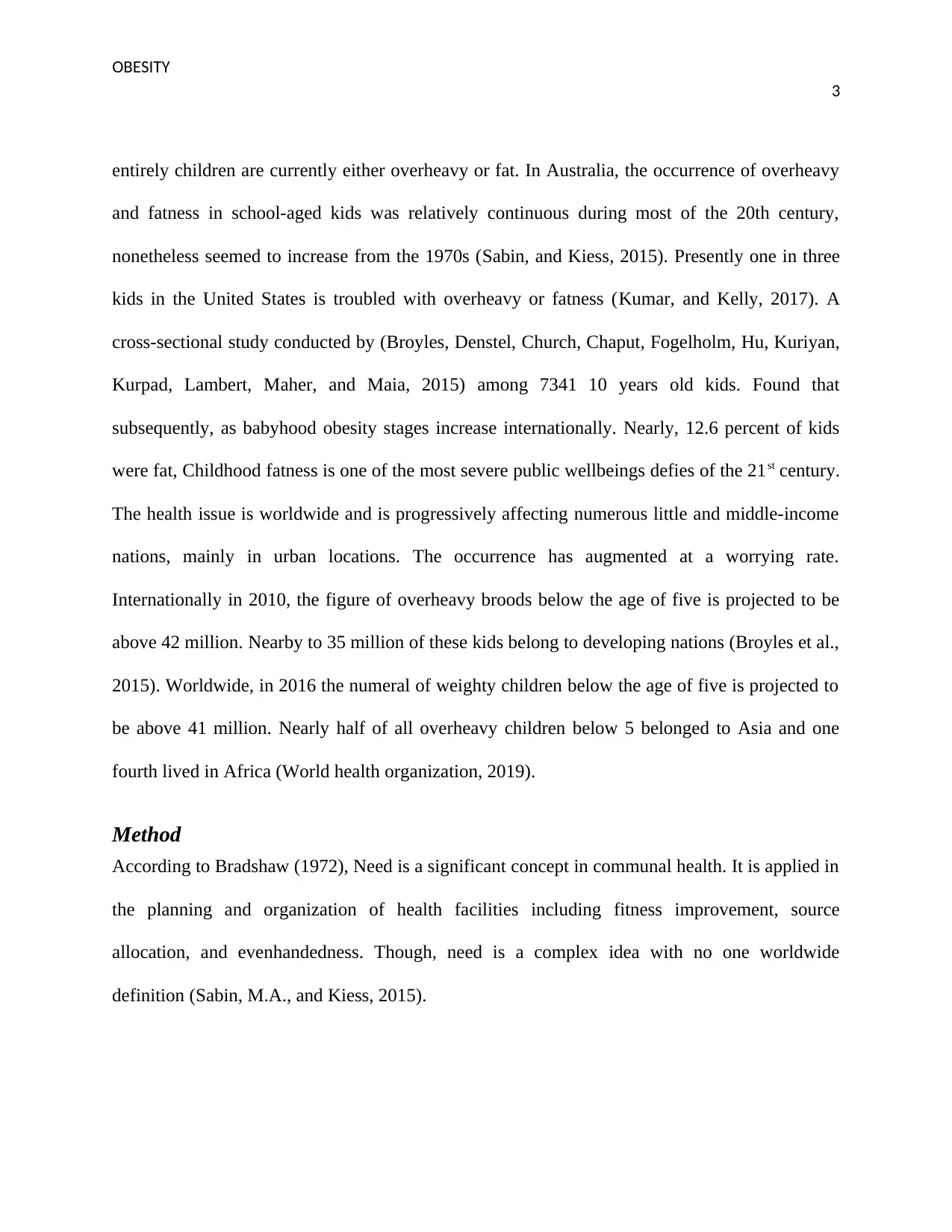
OBESITY
3
entirely children are currently either overheavy or fat. In Australia, the occurrence of overheavy
and fatness in school-aged kids was relatively continuous during most of the 20th century,
nonetheless seemed to increase from the 1970s (Sabin, and Kiess, 2015). Presently one in three
kids in the United States is troubled with overheavy or fatness (Kumar, and Kelly, 2017). A
cross-sectional study conducted by (Broyles, Denstel, Church, Chaput, Fogelholm, Hu, Kuriyan,
Kurpad, Lambert, Maher, and Maia, 2015) among 7341 10 years old kids. Found that
subsequently, as babyhood obesity stages increase internationally. Nearly, 12.6 percent of kids
were fat, Childhood fatness is one of the most severe public wellbeings defies of the 21st century.
The health issue is worldwide and is progressively affecting numerous little and middle-income
nations, mainly in urban locations. The occurrence has augmented at a worrying rate.
Internationally in 2010, the figure of overheavy broods below the age of five is projected to be
above 42 million. Nearby to 35 million of these kids belong to developing nations (Broyles et al.,
2015). Worldwide, in 2016 the numeral of weighty children below the age of five is projected to
be above 41 million. Nearly half of all overheavy children below 5 belonged to Asia and one
fourth lived in Africa (World health organization, 2019).
Method
According to Bradshaw (1972), Need is a significant concept in communal health. It is applied in
the planning and organization of health facilities including fitness improvement, source
allocation, and evenhandedness. Though, need is a complex idea with no one worldwide
definition (Sabin, M.A., and Kiess, 2015).
3
entirely children are currently either overheavy or fat. In Australia, the occurrence of overheavy
and fatness in school-aged kids was relatively continuous during most of the 20th century,
nonetheless seemed to increase from the 1970s (Sabin, and Kiess, 2015). Presently one in three
kids in the United States is troubled with overheavy or fatness (Kumar, and Kelly, 2017). A
cross-sectional study conducted by (Broyles, Denstel, Church, Chaput, Fogelholm, Hu, Kuriyan,
Kurpad, Lambert, Maher, and Maia, 2015) among 7341 10 years old kids. Found that
subsequently, as babyhood obesity stages increase internationally. Nearly, 12.6 percent of kids
were fat, Childhood fatness is one of the most severe public wellbeings defies of the 21st century.
The health issue is worldwide and is progressively affecting numerous little and middle-income
nations, mainly in urban locations. The occurrence has augmented at a worrying rate.
Internationally in 2010, the figure of overheavy broods below the age of five is projected to be
above 42 million. Nearby to 35 million of these kids belong to developing nations (Broyles et al.,
2015). Worldwide, in 2016 the numeral of weighty children below the age of five is projected to
be above 41 million. Nearly half of all overheavy children below 5 belonged to Asia and one
fourth lived in Africa (World health organization, 2019).
Method
According to Bradshaw (1972), Need is a significant concept in communal health. It is applied in
the planning and organization of health facilities including fitness improvement, source
allocation, and evenhandedness. Though, need is a complex idea with no one worldwide
definition (Sabin, M.A., and Kiess, 2015).
Secure Best Marks with AI Grader
Need help grading? Try our AI Grader for instant feedback on your assignments.
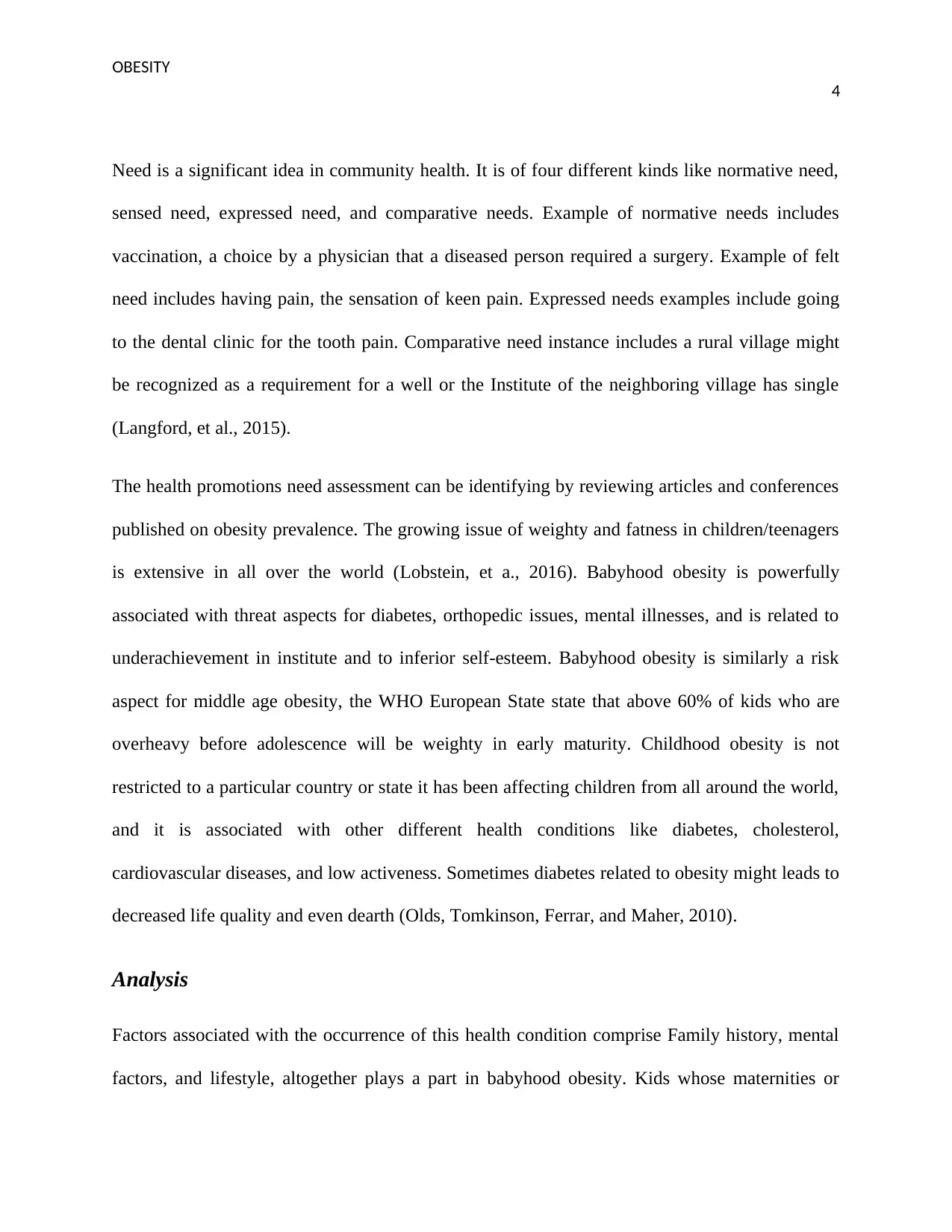
OBESITY
4
Need is a significant idea in community health. It is of four different kinds like normative need,
sensed need, expressed need, and comparative needs. Example of normative needs includes
vaccination, a choice by a physician that a diseased person required a surgery. Example of felt
need includes having pain, the sensation of keen pain. Expressed needs examples include going
to the dental clinic for the tooth pain. Comparative need instance includes a rural village might
be recognized as a requirement for a well or the Institute of the neighboring village has single
(Langford, et al., 2015).
The health promotions need assessment can be identifying by reviewing articles and conferences
published on obesity prevalence. The growing issue of weighty and fatness in children/teenagers
is extensive in all over the world (Lobstein, et a., 2016). Babyhood obesity is powerfully
associated with threat aspects for diabetes, orthopedic issues, mental illnesses, and is related to
underachievement in institute and to inferior self-esteem. Babyhood obesity is similarly a risk
aspect for middle age obesity, the WHO European State state that above 60% of kids who are
overheavy before adolescence will be weighty in early maturity. Childhood obesity is not
restricted to a particular country or state it has been affecting children from all around the world,
and it is associated with other different health conditions like diabetes, cholesterol,
cardiovascular diseases, and low activeness. Sometimes diabetes related to obesity might leads to
decreased life quality and even dearth (Olds, Tomkinson, Ferrar, and Maher, 2010).
Analysis
Factors associated with the occurrence of this health condition comprise Family history, mental
factors, and lifestyle, altogether plays a part in babyhood obesity. Kids whose maternities or
4
Need is a significant idea in community health. It is of four different kinds like normative need,
sensed need, expressed need, and comparative needs. Example of normative needs includes
vaccination, a choice by a physician that a diseased person required a surgery. Example of felt
need includes having pain, the sensation of keen pain. Expressed needs examples include going
to the dental clinic for the tooth pain. Comparative need instance includes a rural village might
be recognized as a requirement for a well or the Institute of the neighboring village has single
(Langford, et al., 2015).
The health promotions need assessment can be identifying by reviewing articles and conferences
published on obesity prevalence. The growing issue of weighty and fatness in children/teenagers
is extensive in all over the world (Lobstein, et a., 2016). Babyhood obesity is powerfully
associated with threat aspects for diabetes, orthopedic issues, mental illnesses, and is related to
underachievement in institute and to inferior self-esteem. Babyhood obesity is similarly a risk
aspect for middle age obesity, the WHO European State state that above 60% of kids who are
overheavy before adolescence will be weighty in early maturity. Childhood obesity is not
restricted to a particular country or state it has been affecting children from all around the world,
and it is associated with other different health conditions like diabetes, cholesterol,
cardiovascular diseases, and low activeness. Sometimes diabetes related to obesity might leads to
decreased life quality and even dearth (Olds, Tomkinson, Ferrar, and Maher, 2010).
Analysis
Factors associated with the occurrence of this health condition comprise Family history, mental
factors, and lifestyle, altogether plays a part in babyhood obesity. Kids whose maternities or
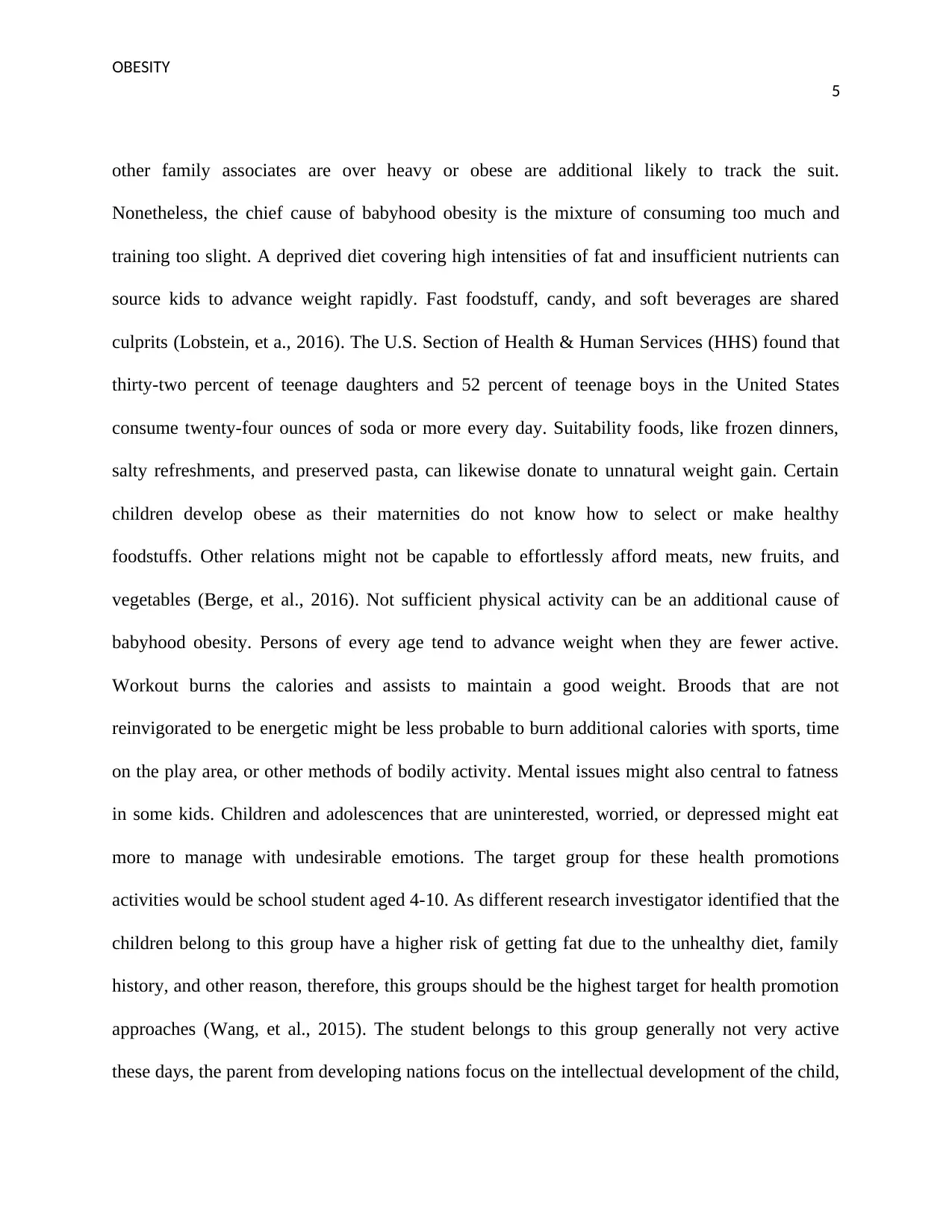
OBESITY
5
other family associates are over heavy or obese are additional likely to track the suit.
Nonetheless, the chief cause of babyhood obesity is the mixture of consuming too much and
training too slight. A deprived diet covering high intensities of fat and insufficient nutrients can
source kids to advance weight rapidly. Fast foodstuff, candy, and soft beverages are shared
culprits (Lobstein, et a., 2016). The U.S. Section of Health & Human Services (HHS) found that
thirty-two percent of teenage daughters and 52 percent of teenage boys in the United States
consume twenty-four ounces of soda or more every day. Suitability foods, like frozen dinners,
salty refreshments, and preserved pasta, can likewise donate to unnatural weight gain. Certain
children develop obese as their maternities do not know how to select or make healthy
foodstuffs. Other relations might not be capable to effortlessly afford meats, new fruits, and
vegetables (Berge, et al., 2016). Not sufficient physical activity can be an additional cause of
babyhood obesity. Persons of every age tend to advance weight when they are fewer active.
Workout burns the calories and assists to maintain a good weight. Broods that are not
reinvigorated to be energetic might be less probable to burn additional calories with sports, time
on the play area, or other methods of bodily activity. Mental issues might also central to fatness
in some kids. Children and adolescences that are uninterested, worried, or depressed might eat
more to manage with undesirable emotions. The target group for these health promotions
activities would be school student aged 4-10. As different research investigator identified that the
children belong to this group have a higher risk of getting fat due to the unhealthy diet, family
history, and other reason, therefore, this groups should be the highest target for health promotion
approaches (Wang, et al., 2015). The student belongs to this group generally not very active
these days, the parent from developing nations focus on the intellectual development of the child,
5
other family associates are over heavy or obese are additional likely to track the suit.
Nonetheless, the chief cause of babyhood obesity is the mixture of consuming too much and
training too slight. A deprived diet covering high intensities of fat and insufficient nutrients can
source kids to advance weight rapidly. Fast foodstuff, candy, and soft beverages are shared
culprits (Lobstein, et a., 2016). The U.S. Section of Health & Human Services (HHS) found that
thirty-two percent of teenage daughters and 52 percent of teenage boys in the United States
consume twenty-four ounces of soda or more every day. Suitability foods, like frozen dinners,
salty refreshments, and preserved pasta, can likewise donate to unnatural weight gain. Certain
children develop obese as their maternities do not know how to select or make healthy
foodstuffs. Other relations might not be capable to effortlessly afford meats, new fruits, and
vegetables (Berge, et al., 2016). Not sufficient physical activity can be an additional cause of
babyhood obesity. Persons of every age tend to advance weight when they are fewer active.
Workout burns the calories and assists to maintain a good weight. Broods that are not
reinvigorated to be energetic might be less probable to burn additional calories with sports, time
on the play area, or other methods of bodily activity. Mental issues might also central to fatness
in some kids. Children and adolescences that are uninterested, worried, or depressed might eat
more to manage with undesirable emotions. The target group for these health promotions
activities would be school student aged 4-10. As different research investigator identified that the
children belong to this group have a higher risk of getting fat due to the unhealthy diet, family
history, and other reason, therefore, this groups should be the highest target for health promotion
approaches (Wang, et al., 2015). The student belongs to this group generally not very active
these days, the parent from developing nations focus on the intellectual development of the child,
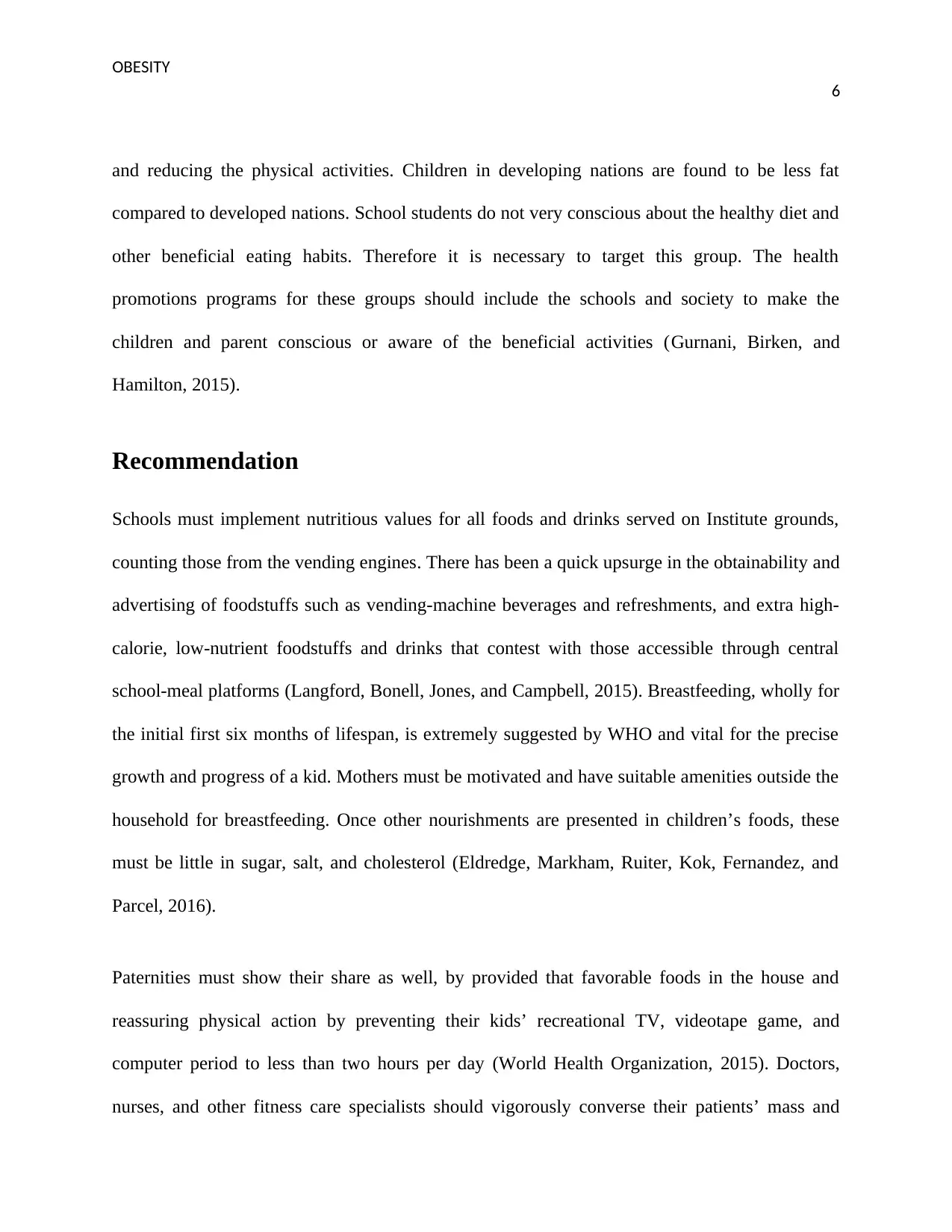
OBESITY
6
and reducing the physical activities. Children in developing nations are found to be less fat
compared to developed nations. School students do not very conscious about the healthy diet and
other beneficial eating habits. Therefore it is necessary to target this group. The health
promotions programs for these groups should include the schools and society to make the
children and parent conscious or aware of the beneficial activities (Gurnani, Birken, and
Hamilton, 2015).
Recommendation
Schools must implement nutritious values for all foods and drinks served on Institute grounds,
counting those from the vending engines. There has been a quick upsurge in the obtainability and
advertising of foodstuffs such as vending-machine beverages and refreshments, and extra high-
calorie, low-nutrient foodstuffs and drinks that contest with those accessible through central
school-meal platforms (Langford, Bonell, Jones, and Campbell, 2015). Breastfeeding, wholly for
the initial first six months of lifespan, is extremely suggested by WHO and vital for the precise
growth and progress of a kid. Mothers must be motivated and have suitable amenities outside the
household for breastfeeding. Once other nourishments are presented in children’s foods, these
must be little in sugar, salt, and cholesterol (Eldredge, Markham, Ruiter, Kok, Fernandez, and
Parcel, 2016).
Paternities must show their share as well, by provided that favorable foods in the house and
reassuring physical action by preventing their kids’ recreational TV, videotape game, and
computer period to less than two hours per day (World Health Organization, 2015). Doctors,
nurses, and other fitness care specialists should vigorously converse their patients’ mass and
6
and reducing the physical activities. Children in developing nations are found to be less fat
compared to developed nations. School students do not very conscious about the healthy diet and
other beneficial eating habits. Therefore it is necessary to target this group. The health
promotions programs for these groups should include the schools and society to make the
children and parent conscious or aware of the beneficial activities (Gurnani, Birken, and
Hamilton, 2015).
Recommendation
Schools must implement nutritious values for all foods and drinks served on Institute grounds,
counting those from the vending engines. There has been a quick upsurge in the obtainability and
advertising of foodstuffs such as vending-machine beverages and refreshments, and extra high-
calorie, low-nutrient foodstuffs and drinks that contest with those accessible through central
school-meal platforms (Langford, Bonell, Jones, and Campbell, 2015). Breastfeeding, wholly for
the initial first six months of lifespan, is extremely suggested by WHO and vital for the precise
growth and progress of a kid. Mothers must be motivated and have suitable amenities outside the
household for breastfeeding. Once other nourishments are presented in children’s foods, these
must be little in sugar, salt, and cholesterol (Eldredge, Markham, Ruiter, Kok, Fernandez, and
Parcel, 2016).
Paternities must show their share as well, by provided that favorable foods in the house and
reassuring physical action by preventing their kids’ recreational TV, videotape game, and
computer period to less than two hours per day (World Health Organization, 2015). Doctors,
nurses, and other fitness care specialists should vigorously converse their patients’ mass and
Paraphrase This Document
Need a fresh take? Get an instant paraphrase of this document with our AI Paraphraser
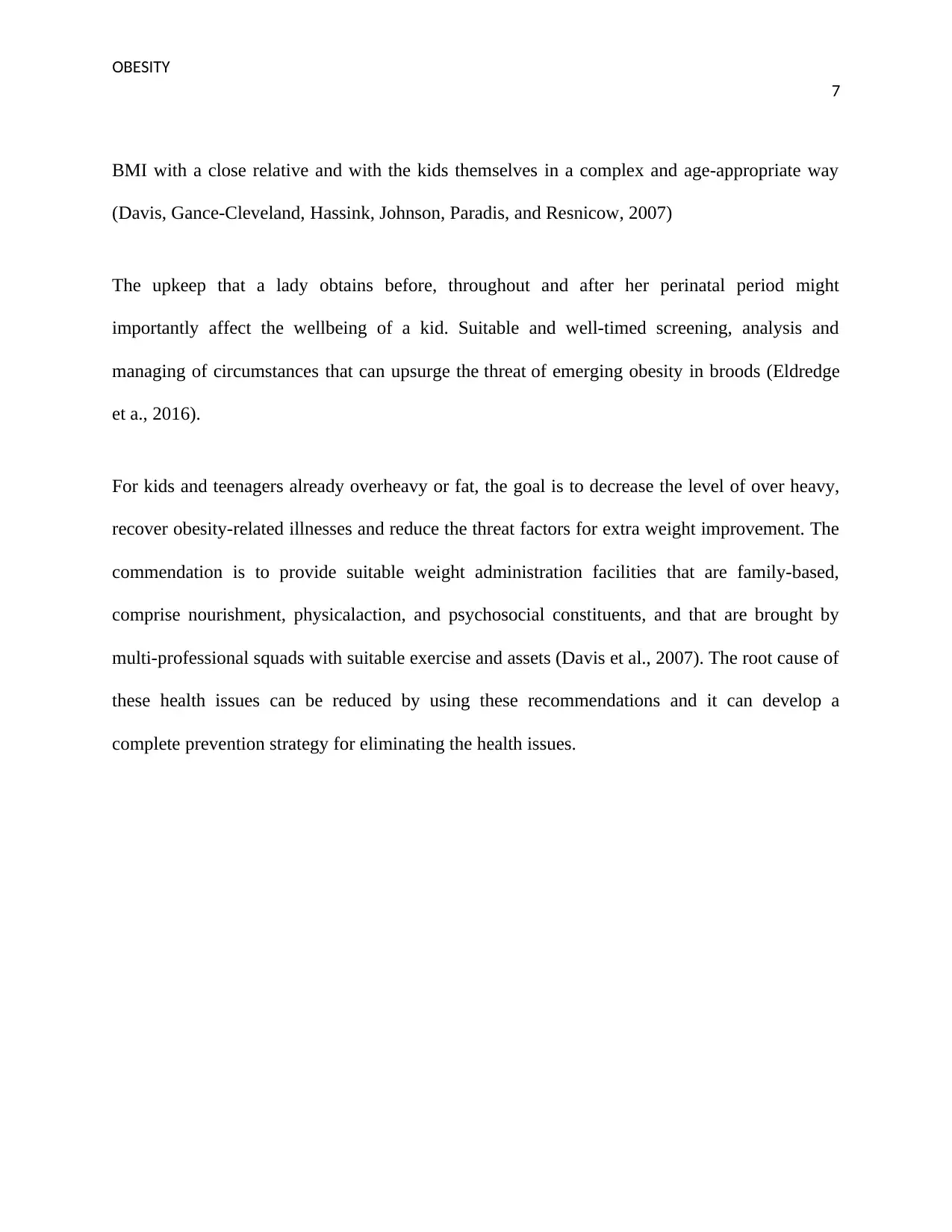
OBESITY
7
BMI with a close relative and with the kids themselves in a complex and age-appropriate way
(Davis, Gance-Cleveland, Hassink, Johnson, Paradis, and Resnicow, 2007)
The upkeep that a lady obtains before, throughout and after her perinatal period might
importantly affect the wellbeing of a kid. Suitable and well-timed screening, analysis and
managing of circumstances that can upsurge the threat of emerging obesity in broods (Eldredge
et a., 2016).
For kids and teenagers already overheavy or fat, the goal is to decrease the level of over heavy,
recover obesity-related illnesses and reduce the threat factors for extra weight improvement. The
commendation is to provide suitable weight administration facilities that are family-based,
comprise nourishment, physicalaction, and psychosocial constituents, and that are brought by
multi-professional squads with suitable exercise and assets (Davis et al., 2007). The root cause of
these health issues can be reduced by using these recommendations and it can develop a
complete prevention strategy for eliminating the health issues.
7
BMI with a close relative and with the kids themselves in a complex and age-appropriate way
(Davis, Gance-Cleveland, Hassink, Johnson, Paradis, and Resnicow, 2007)
The upkeep that a lady obtains before, throughout and after her perinatal period might
importantly affect the wellbeing of a kid. Suitable and well-timed screening, analysis and
managing of circumstances that can upsurge the threat of emerging obesity in broods (Eldredge
et a., 2016).
For kids and teenagers already overheavy or fat, the goal is to decrease the level of over heavy,
recover obesity-related illnesses and reduce the threat factors for extra weight improvement. The
commendation is to provide suitable weight administration facilities that are family-based,
comprise nourishment, physicalaction, and psychosocial constituents, and that are brought by
multi-professional squads with suitable exercise and assets (Davis et al., 2007). The root cause of
these health issues can be reduced by using these recommendations and it can develop a
complete prevention strategy for eliminating the health issues.
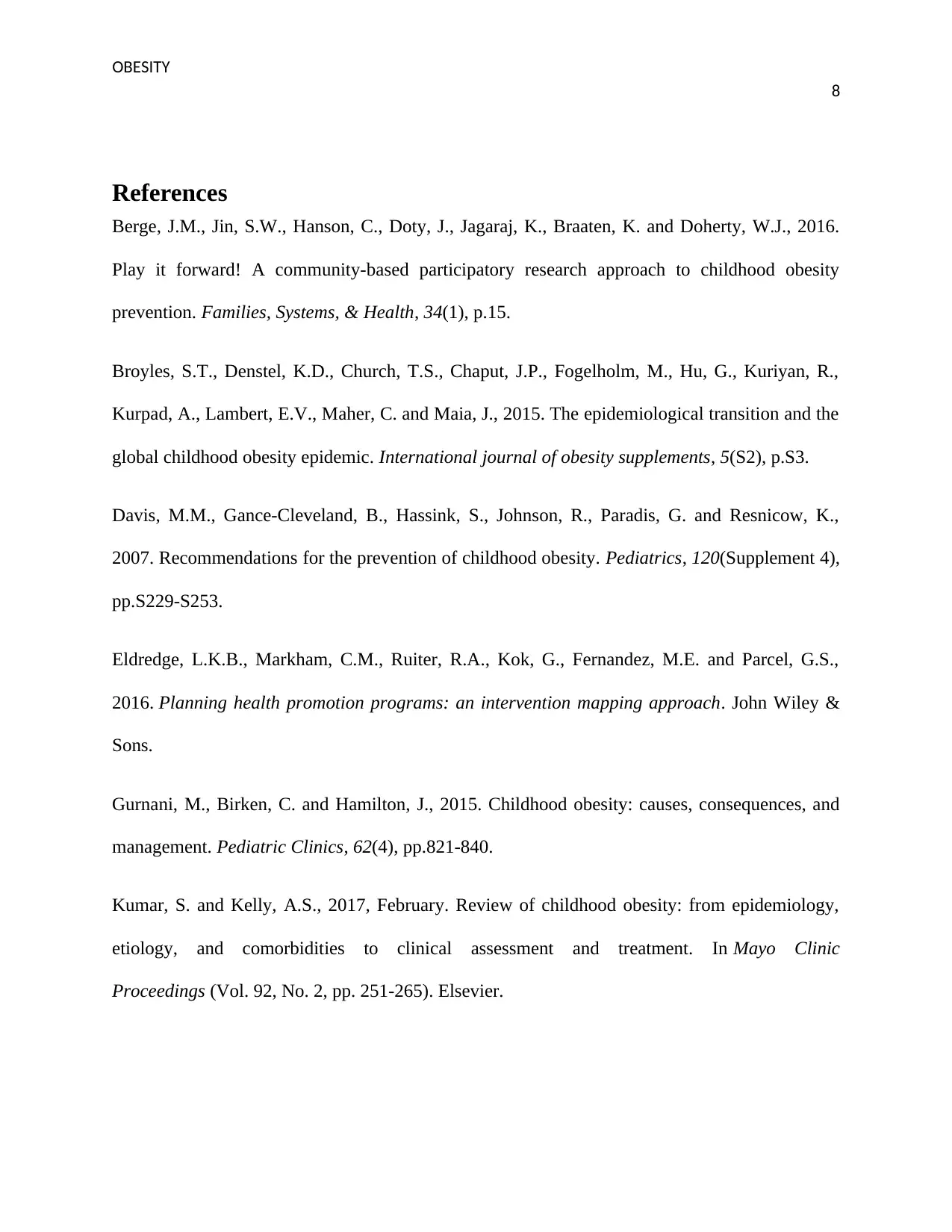
OBESITY
8
References
Berge, J.M., Jin, S.W., Hanson, C., Doty, J., Jagaraj, K., Braaten, K. and Doherty, W.J., 2016.
Play it forward! A community-based participatory research approach to childhood obesity
prevention. Families, Systems, & Health, 34(1), p.15.
Broyles, S.T., Denstel, K.D., Church, T.S., Chaput, J.P., Fogelholm, M., Hu, G., Kuriyan, R.,
Kurpad, A., Lambert, E.V., Maher, C. and Maia, J., 2015. The epidemiological transition and the
global childhood obesity epidemic. International journal of obesity supplements, 5(S2), p.S3.
Davis, M.M., Gance-Cleveland, B., Hassink, S., Johnson, R., Paradis, G. and Resnicow, K.,
2007. Recommendations for the prevention of childhood obesity. Pediatrics, 120(Supplement 4),
pp.S229-S253.
Eldredge, L.K.B., Markham, C.M., Ruiter, R.A., Kok, G., Fernandez, M.E. and Parcel, G.S.,
2016. Planning health promotion programs: an intervention mapping approach. John Wiley &
Sons.
Gurnani, M., Birken, C. and Hamilton, J., 2015. Childhood obesity: causes, consequences, and
management. Pediatric Clinics, 62(4), pp.821-840.
Kumar, S. and Kelly, A.S., 2017, February. Review of childhood obesity: from epidemiology,
etiology, and comorbidities to clinical assessment and treatment. In Mayo Clinic
Proceedings (Vol. 92, No. 2, pp. 251-265). Elsevier.
8
References
Berge, J.M., Jin, S.W., Hanson, C., Doty, J., Jagaraj, K., Braaten, K. and Doherty, W.J., 2016.
Play it forward! A community-based participatory research approach to childhood obesity
prevention. Families, Systems, & Health, 34(1), p.15.
Broyles, S.T., Denstel, K.D., Church, T.S., Chaput, J.P., Fogelholm, M., Hu, G., Kuriyan, R.,
Kurpad, A., Lambert, E.V., Maher, C. and Maia, J., 2015. The epidemiological transition and the
global childhood obesity epidemic. International journal of obesity supplements, 5(S2), p.S3.
Davis, M.M., Gance-Cleveland, B., Hassink, S., Johnson, R., Paradis, G. and Resnicow, K.,
2007. Recommendations for the prevention of childhood obesity. Pediatrics, 120(Supplement 4),
pp.S229-S253.
Eldredge, L.K.B., Markham, C.M., Ruiter, R.A., Kok, G., Fernandez, M.E. and Parcel, G.S.,
2016. Planning health promotion programs: an intervention mapping approach. John Wiley &
Sons.
Gurnani, M., Birken, C. and Hamilton, J., 2015. Childhood obesity: causes, consequences, and
management. Pediatric Clinics, 62(4), pp.821-840.
Kumar, S. and Kelly, A.S., 2017, February. Review of childhood obesity: from epidemiology,
etiology, and comorbidities to clinical assessment and treatment. In Mayo Clinic
Proceedings (Vol. 92, No. 2, pp. 251-265). Elsevier.
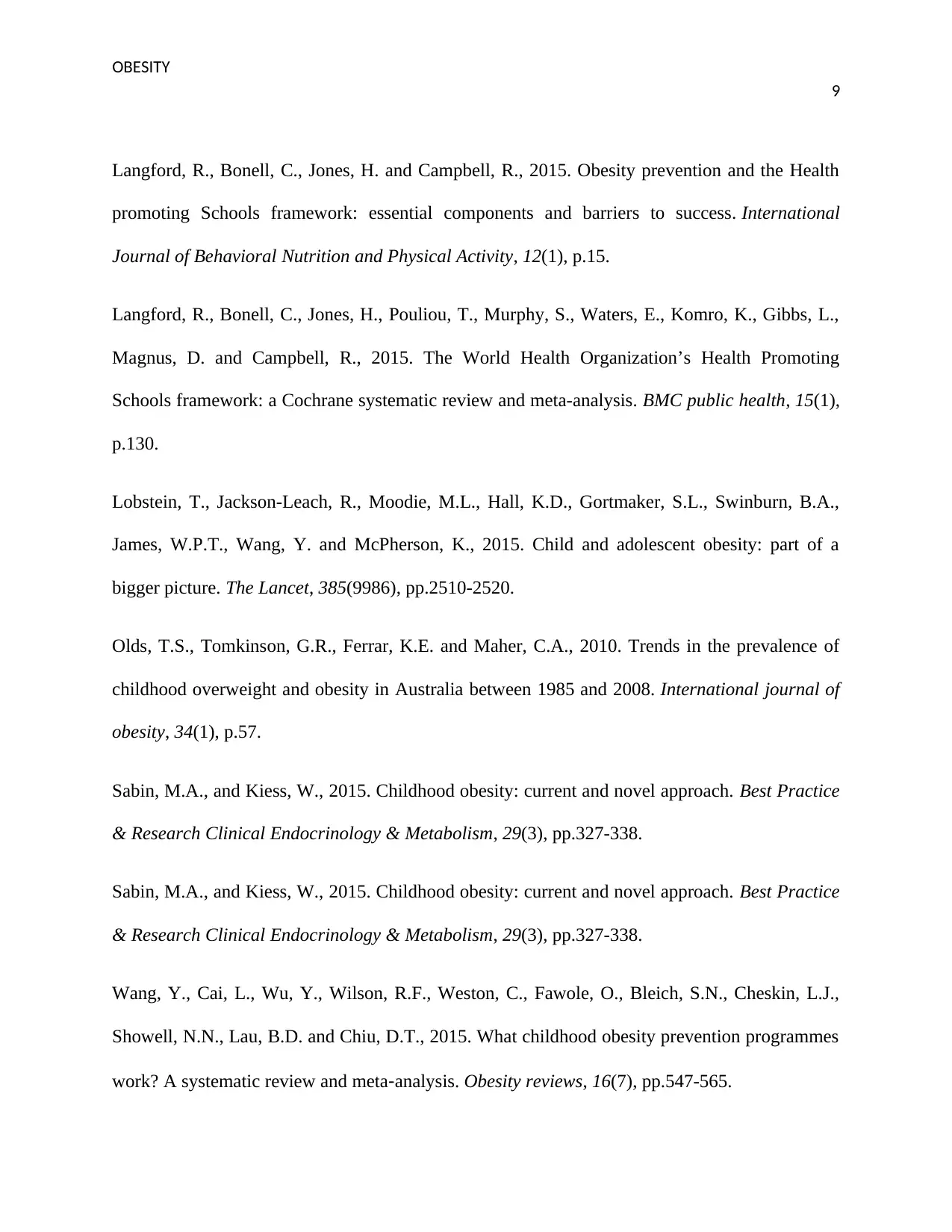
OBESITY
9
Langford, R., Bonell, C., Jones, H. and Campbell, R., 2015. Obesity prevention and the Health
promoting Schools framework: essential components and barriers to success. International
Journal of Behavioral Nutrition and Physical Activity, 12(1), p.15.
Langford, R., Bonell, C., Jones, H., Pouliou, T., Murphy, S., Waters, E., Komro, K., Gibbs, L.,
Magnus, D. and Campbell, R., 2015. The World Health Organization’s Health Promoting
Schools framework: a Cochrane systematic review and meta-analysis. BMC public health, 15(1),
p.130.
Lobstein, T., Jackson-Leach, R., Moodie, M.L., Hall, K.D., Gortmaker, S.L., Swinburn, B.A.,
James, W.P.T., Wang, Y. and McPherson, K., 2015. Child and adolescent obesity: part of a
bigger picture. The Lancet, 385(9986), pp.2510-2520.
Olds, T.S., Tomkinson, G.R., Ferrar, K.E. and Maher, C.A., 2010. Trends in the prevalence of
childhood overweight and obesity in Australia between 1985 and 2008. International journal of
obesity, 34(1), p.57.
Sabin, M.A., and Kiess, W., 2015. Childhood obesity: current and novel approach. Best Practice
& Research Clinical Endocrinology & Metabolism, 29(3), pp.327-338.
Sabin, M.A., and Kiess, W., 2015. Childhood obesity: current and novel approach. Best Practice
& Research Clinical Endocrinology & Metabolism, 29(3), pp.327-338.
Wang, Y., Cai, L., Wu, Y., Wilson, R.F., Weston, C., Fawole, O., Bleich, S.N., Cheskin, L.J.,
Showell, N.N., Lau, B.D. and Chiu, D.T., 2015. What childhood obesity prevention programmes
work? A systematic review and meta‐analysis. Obesity reviews, 16(7), pp.547-565.
9
Langford, R., Bonell, C., Jones, H. and Campbell, R., 2015. Obesity prevention and the Health
promoting Schools framework: essential components and barriers to success. International
Journal of Behavioral Nutrition and Physical Activity, 12(1), p.15.
Langford, R., Bonell, C., Jones, H., Pouliou, T., Murphy, S., Waters, E., Komro, K., Gibbs, L.,
Magnus, D. and Campbell, R., 2015. The World Health Organization’s Health Promoting
Schools framework: a Cochrane systematic review and meta-analysis. BMC public health, 15(1),
p.130.
Lobstein, T., Jackson-Leach, R., Moodie, M.L., Hall, K.D., Gortmaker, S.L., Swinburn, B.A.,
James, W.P.T., Wang, Y. and McPherson, K., 2015. Child and adolescent obesity: part of a
bigger picture. The Lancet, 385(9986), pp.2510-2520.
Olds, T.S., Tomkinson, G.R., Ferrar, K.E. and Maher, C.A., 2010. Trends in the prevalence of
childhood overweight and obesity in Australia between 1985 and 2008. International journal of
obesity, 34(1), p.57.
Sabin, M.A., and Kiess, W., 2015. Childhood obesity: current and novel approach. Best Practice
& Research Clinical Endocrinology & Metabolism, 29(3), pp.327-338.
Sabin, M.A., and Kiess, W., 2015. Childhood obesity: current and novel approach. Best Practice
& Research Clinical Endocrinology & Metabolism, 29(3), pp.327-338.
Wang, Y., Cai, L., Wu, Y., Wilson, R.F., Weston, C., Fawole, O., Bleich, S.N., Cheskin, L.J.,
Showell, N.N., Lau, B.D. and Chiu, D.T., 2015. What childhood obesity prevention programmes
work? A systematic review and meta‐analysis. Obesity reviews, 16(7), pp.547-565.
Secure Best Marks with AI Grader
Need help grading? Try our AI Grader for instant feedback on your assignments.
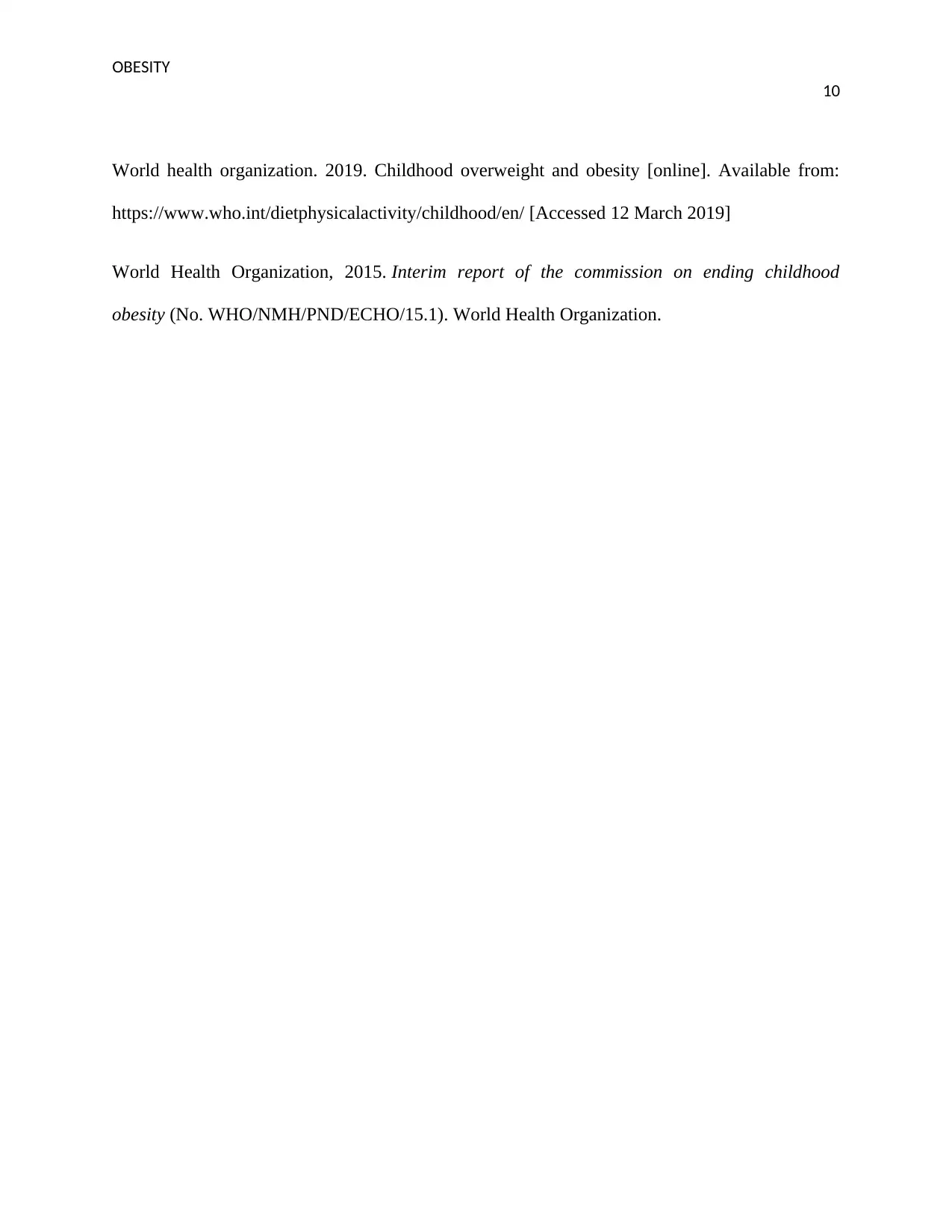
OBESITY
10
World health organization. 2019. Childhood overweight and obesity [online]. Available from:
https://www.who.int/dietphysicalactivity/childhood/en/ [Accessed 12 March 2019]
World Health Organization, 2015. Interim report of the commission on ending childhood
obesity (No. WHO/NMH/PND/ECHO/15.1). World Health Organization.
10
World health organization. 2019. Childhood overweight and obesity [online]. Available from:
https://www.who.int/dietphysicalactivity/childhood/en/ [Accessed 12 March 2019]
World Health Organization, 2015. Interim report of the commission on ending childhood
obesity (No. WHO/NMH/PND/ECHO/15.1). World Health Organization.
1 out of 11
Related Documents
Your All-in-One AI-Powered Toolkit for Academic Success.
+13062052269
info@desklib.com
Available 24*7 on WhatsApp / Email
![[object Object]](/_next/static/media/star-bottom.7253800d.svg)
Unlock your academic potential
© 2024 | Zucol Services PVT LTD | All rights reserved.
